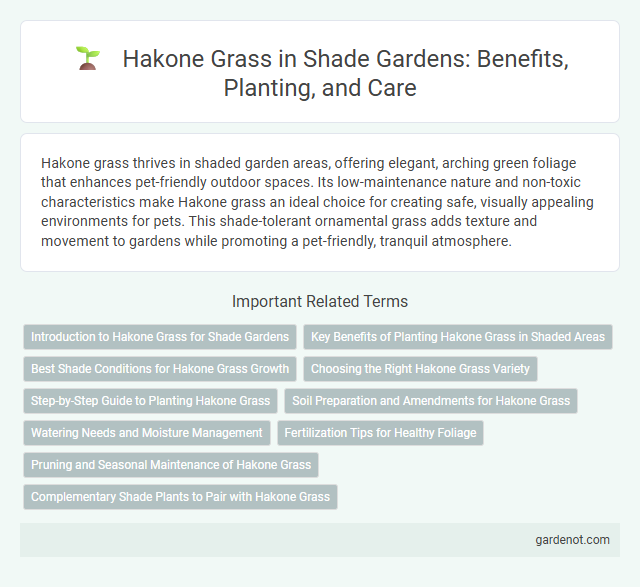Hakone grass thrives in shaded garden areas, offering elegant, arching green foliage that enhances pet-friendly outdoor spaces. Its low-maintenance nature and non-toxic characteristics make Hakone grass an ideal choice for creating safe, visually appealing environments for pets. This shade-tolerant ornamental grass adds texture and movement to gardens while promoting a pet-friendly, tranquil atmosphere.
Introduction to Hakone Grass for Shade Gardens
Hakone grass (Hakonechloa macra) is a versatile, shade-loving ornamental grass ideal for shaded garden areas. Its graceful, arching foliage thrives in partial to full shade, providing vibrant green or variegated leaves that enhance texture and contrast in shade garden landscapes. This low-maintenance plant adapts well to moist, well-drained soils, making it a popular choice for adding movement and elegance to shaded garden beds or borders.
Key Benefits of Planting Hakone Grass in Shaded Areas
Hakone grass thrives in shaded garden areas, offering excellent ground cover that prevents soil erosion and retains moisture. Its graceful, arching leaves add texture and vibrant green hues, enhancing the aesthetic appeal of dimly lit spots. This hardy perennial requires low maintenance and creates a lush, tranquil environment ideal for shade gardens.
Best Shade Conditions for Hakone Grass Growth
Hakone grass thrives in partial to full shade environments, making it ideal for shaded garden areas with filtered sunlight or dappled shade. It prefers well-drained, moist soil with consistent humidity to encourage lush foliage and vibrant color. Avoid direct afternoon sun, which can scorch the delicate leaves and hinder healthy growth.
Choosing the Right Hakone Grass Variety
Selecting the right Hakone grass variety is crucial for thriving shade gardens, with popular options including Hakonechloa macra 'Aureola' known for its golden-striped leaves and tolerant of partial shade. Choosing cultivars like 'All Gold' maximizes brightness in darker areas, while 'Albostriata' offers striking white-striped foliage for added visual interest. Consider growth habits and light preferences to ensure optimal health and aesthetic appeal in shaded landscapes.
Step-by-Step Guide to Planting Hakone Grass
Choose a shaded or partially shaded location with well-draining soil enriched with organic matter to plant Hakone grass. Dig a hole twice as wide as the root ball, gently loosen the roots, and place the plant at ground level before backfilling with soil and pressing firmly. Water thoroughly after planting and maintain consistent moisture while avoiding waterlogging to promote healthy growth of Hakone grass in shade gardens.
Soil Preparation and Amendments for Hakone Grass
Hakone grass thrives in well-draining, organically rich soil with a slightly acidic to neutral pH between 6.0 and 7.0. Incorporate organic matter such as compost or aged leaf mold to enhance soil fertility and moisture retention while improving texture. Ensure loose soil structure by mixing in coarse sand or small bark chips to prevent waterlogging and support healthy root development for Hakone grass.
Watering Needs and Moisture Management
Hakone grass thrives in consistently moist, well-drained soil, making regular watering essential, especially during dry spells. Overwatering can lead to root rot, so maintaining balanced moisture without waterlogging is critical for healthy growth. Mulching around the base helps retain soil moisture and regulates temperature in shade gardens.
Fertilization Tips for Healthy Foliage
Hakone grass thrives with balanced fertilization, benefiting from a slow-release fertilizer high in nitrogen to promote lush green foliage. Applying fertilizer in early spring and mid-summer supports steady growth and vibrant leaf color. Avoid excessive nitrogen, which can lead to weak stems and reduced durability in shaded garden settings.
Pruning and Seasonal Maintenance of Hakone Grass
Pruning Hakone grass involves cutting back the foliage to about 2-3 inches above the ground in late winter or early spring to encourage healthy new growth. Seasonal maintenance includes removing dead or damaged stems and ensuring the plant receives adequate moisture during summer, while avoiding waterlogging. Regular upkeep helps maintain the ornamental appearance and promotes vigorous growth throughout the growing season.
Complementary Shade Plants to Pair with Hakone Grass
Complementary shade plants for Hakone grass include hostas, ferns, and astilbes, which thrive in similar low-light environments and enhance its graceful, arching foliage. Ferns offer a lush, textured backdrop, while hostas contribute bold leaf shapes and contrasting colors, creating a dynamic layered effect. Astilbes add delicate, plume-like flowers that introduce seasonal interest and complement the soft green tones of Hakone grass.
Hakone grass Infographic

 gardenot.com
gardenot.com